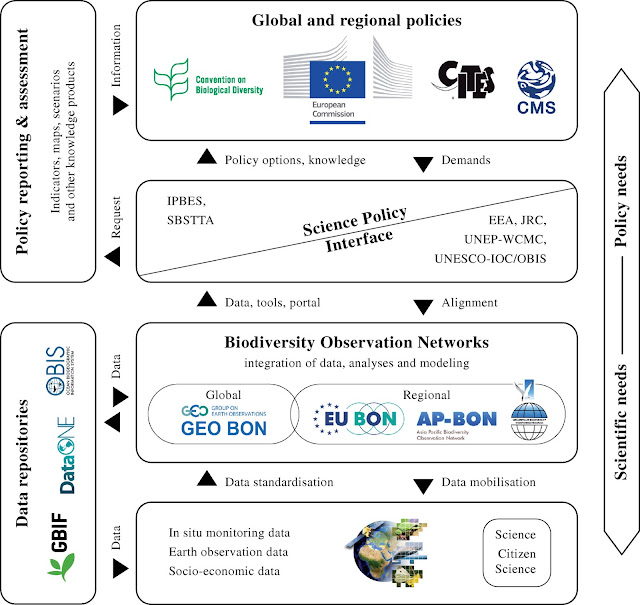(BONs), such as
the European Biodiversity Observation Network (EU BON), for use in policy
implementation.
Data leveraged from various sources are standardised and integrated by BONs
(e.g. application
of standards, creation of data and knowledge products, modelling),
whilst ensuring
alignment with policy needs.
(September 24, 2015) Biodiversity
Observation Networks (BONs) have recently become a hot topic on the scene of
natural sciences. But what is their role in advancing our knowledge of
biodiversity and associated ecosystem services?
A new paper in the Biodiversity journal uses the European
Biodiversity Observation Network (EU BON) as an example, to explain how they
can fill in gaps and address existing barriers in knowledge through
implementing an integrated biodiversity information framework.
This figure
illustrates geographical gaps in biodiversity data in Europe, using Arthropoda
as an
example. The
figure uses 12.62 million occurrence records (globally) from 1970 to March
2015,
accessed from the
Global Biodiversity Information Facility (GBIF).
Lighter colours
indicate more available data
Biodiversity supports essential ecosystem services that are
key to human well-being. The ongoing global biodiversity decline is a threat to
humans, particularly in developing countries.
The Aichi biodiversity targets of the United Nations' Strategic
Plan for Biodiversity set ambitious goals for protecting biodiversity from
further decline, but gaps in knowledge still sit in the way of monitoring
progress, hindering the assessment of the current status and future trends of
biodiversity.
There is an urgent need for a paradigm shift with regards to
how biodiversity data are collected, stored, shared and streamlined in order to
tackle many sustainable development challenges ahead.
Solving issues of biodiversity knowledge gaps and data reuse
are a main focus of the EU BON project and provide a European contribution to
GEO (Group on Earth Observations) and the wider Global Earth Observation System
of Systems (GEOSS).
The EU BON project aims at addressing the need for a shift
towards an integrative biodiversity information framework, starting from
collection to the final interpretation and packaging of data.


